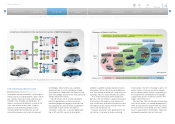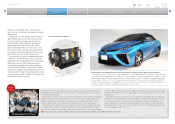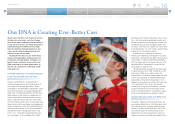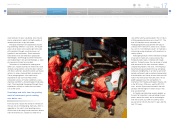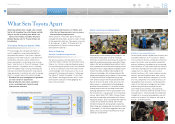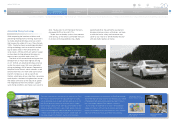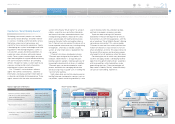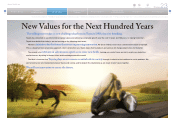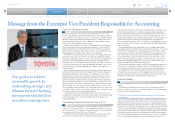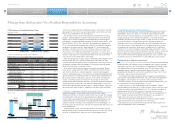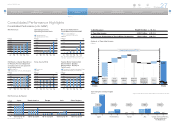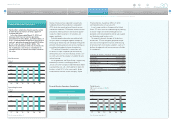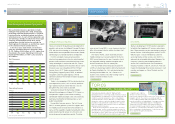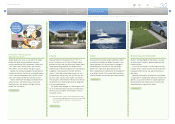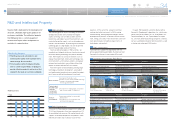Toyota 2014 Annual Report Download - page 24
Download and view the complete annual report
Please find page 24 of the 2014 Toyota annual report below. You can navigate through the pages in the report by either clicking on the pages listed below, or by using the keyword search tool below to find specific information within the annual report.
ANNUAL REPORT 2014
President’s MessagePresident’s Message
Overview of
Four Business Units
Overview of
Four Business Units
Special FeatureSpecial Feature
Review of OperationsReview of Operations
Consolidated Performance
Highlights
Consolidated Performance
Highlights
Management and
Corporate Information
Management and
Corporate Information
Investor InformationInvestor Information
Financial SectionFinancial Section
Page 24
NextPrev
ContentsSearchPrint
exchange-rate fluctuations (¥95 billion), marketing efforts (¥45 billion), and
an increase in expenses (¥17.1 billion) to negatively impact operating
income. While the aforementioned cost reduction efforts and the absence
of the one-off expense incurred in the fiscal year ended March 31, 2014,
will help boost earnings, the anticipated deterioration in model composition,
impact of low-priced currencies in emerging markets, and aggressive
forward-looking expenditures aimed at securing sustainable growth on the
back of increased competitiveness are projected to hold operating income
at its current level.
We will be looking to build a foundation that is capable of generating
sustainable growth by implementing a wide range of measures. As we work
to enhance our competitiveness by developing human resources, under-
taking capital investments, and implementing our new management struc-
ture, we will take care not to be overly influenced by short-term financial
results. Meanwhile, in order to absorb the increase in fixed costs associ-
ated with forward-looking investments, we will not let up in our efforts to
reduce costs through Companywide value analysis (VA) activities, or to
improve profitability by efficiently promoting sales.
We have been aiming to establish a cycle of developing ever-better cars
that delight our customers and benefit society while fulfilling our duty to
increase sales and profits that are, of course, reinvested in development.
To support this cycle, we will endeavor to maintain and build on our
strong earnings base and to steadfastly engage in activities that improve
our profit structure. To this end, we will continue to increase the gross profit
margin per unit and place suitable controls on fixed costs.
Financial Strategy
The three key priorities of our financial strategy are growth, efficiency, and
stability.
We believe that the balanced pursuit of these three priorities over the
medium to long term will allow us to achieve steady and sustainable growth
as well as increase corporate value.
1. Growth: Sustainable growth through continuous forward-looking
investments
The structure of the automotive market is undergoing dramatic change.
Along with burgeoning environmental awareness, we are witnessing rising
demand for diverse types of eco cars as well as the rapid development of
information technology and telecommunications. At the same time, global
competition is becoming increasingly fierce. Focusing on environmental and
safety as well as information and telecommunications technology develop-
ment and investing capital in areas aimed at enhancing productivity, Toyota
will actively undertake all necessary expenditure to remain at the forefront.
This will include the development of human resources, which we recognize
is key to maximizing conscientious manufacturing and investment in IT
Message from the Executive Vice President Responsible for Accounting
Our goal is to achieve
sustainable growth by
undertaking strategic and
efficient forward-looking
investments that build on
our robust earnings base.
Fiscal 2014 Business Results
On a consolidated basis for the fiscal year ended March 31, 2014, the
Toyota Group reported an increase in both revenue and earnings. Vehicle
sales increased 0.245 million units to 9.116 million units compared with the
previous fiscal year. Net revenues expanded ¥3.6277 trillion to ¥25.6919
trillion, operating income grew ¥971.2 billion to ¥2,292.1 billion, and net
income rose ¥860.9 billion to ¥1,823.1 billion.
Factors that contributed to the increase in operating income included a
¥900.0 billion boost due to exchange-rate fluctuations as well as ¥290.0
billion contributed by cost reduction efforts, ¥180.0 billion by marketing
efforts, and ¥81.2 billion by other factors. Factors that were detrimental to
operating income included a ¥480.0 billion rise in expenses.
The increase in miscellaneous costs and others was largely attributable
to non-recurring expenses incurred as a result of an agreement reached
with the U.S. Attorney’s Office. In contrast, the Company’s earnings for the
fiscal year under review benefitted from movements in foreign currency
exchange rates, most notably the weakening of the yen against both the
U.S. dollar and the euro, the improving profitability of exports, the success
of cost reductions undertaken together with suppliers, and aggressive
marketing efforts.
From a marketing perspective, the active release of fully remodeled cars,
including the Harrier, Voxy, and Noah, together with the efforts of dealers
nationwide helped boost sales in Japan. On a global basis, the Group’s
performance was mixed. Sales stalled in Thailand and India due mainly to
market contraction and increasingly fierce competition. In contrast, the
continued recovery in North America, coupled with the release of remod-
eled cars, including the RAV4, Lexus IS, and Tundra, served to drive sales
forward. We thus saw vehicle sales grow mainly in North America, Europe,
and the Middle East. The sales increase in Japan and across many coun-
tries and regions worldwide reflects the introduction of new car models that
accurately address the needs of domestic and overseas customers as well
as the intense efforts of the Group’s global dealers.
I strongly believe that the revitalization of the Group’s operations and
management is attributable to the hard work of dealers and suppliers along
with the concerted efforts of the entire Toyota Group of companies to
improve profitability.
Consolidated Financial Forecasts for Fiscal 2015
For the fiscal year ending March 31, 2015, we forecast vehicle sales of 9.1
million units, net revenues of ¥25.7 trillion, operating income of ¥2.3 trillion,
and net income of ¥1.78 trillion on a consolidated basis. Our exchange rate
assumptions are ¥100 per US$1 and ¥140 per a1.
In our forecast for consolidate operating income we expect cost reduc-
tion efforts (¥165 billion) to be a contributing factor. We also expect
Toyota in 10 Years and 100 Years Our DNA is Creating Ever-Better Cars What Sets Toyota Apart Enriching Lives and Building Tomorrow’s Toyota through Innovation New Values for the Next Hundred Years Message from the Executive Vice President Responsible for Accounting [1 of 2]


